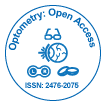Wearables: The Future of Personalized Health and Connectivity
Received: 03-Mar-2025 / Manuscript No. omoa-25-170231 / Editor assigned: 05-Mar-2025 / PreQC No. omoa-25-170231 / Reviewed: 18-Mar-2025 / QC No. omoa-25-170231 / Revised: 23-Mar-2025 / Manuscript No. omoa-25-170231 / Published Date: 29-Mar-2025 DOI: 10.4172/2476-2075.1000308
Introduction
Wearable technology, commonly referred to as "wearables," has rapidly become a staple in modern life. These smart electronic devices, worn on the body—such as smartwatches, fitness trackers, and health-monitoring bands—are designed to collect and deliver real-time data about physical activity, health metrics, and even environmental conditions. Initially popularized in the fitness and lifestyle sectors, wearables are now making significant strides in healthcare, sports, workplace safety, and beyond. Their ability to offer continuous, personalized, and actionable insights is transforming how individuals interact with their own health and daily routines [1],[2].
Discussion
The primary appeal of wearables lies in their ability to monitor various physiological functions such as heart rate, sleep patterns, physical activity, body temperature, oxygen levels, and even stress indicators. For fitness enthusiasts, these devices provide motivation and accountability by tracking daily steps, workouts, calories burned, and progress toward health goals. In addition, wearables like GPS-enabled smartwatches are useful for navigation and location tracking, enhancing convenience and safety for outdoor activities [3],[4].
In healthcare, wearables are becoming powerful tools for both patients and professionals. Devices capable of monitoring heart rhythms, glucose levels, or detecting falls can assist in early diagnosis, remote monitoring, and chronic disease management. For example, individuals with conditions such as diabetes, hypertension, or heart disease can benefit from continuous monitoring that alerts them—and their healthcare providers—of irregular readings, enabling timely interventions. This remote care model is particularly valuable for elderly patients or those living in remote areas, where frequent hospital visits may not be feasible [5],[6].
Wearables also play a crucial role in workplace safety and productivity. In industries like construction or manufacturing, smart helmets and vests can monitor vital signs, detect fatigue, and track hazardous exposure, helping prevent accidents and improve worker well-being. Moreover, in corporate settings, wearables are being used to promote employee wellness by encouraging physical activity and healthy habits, potentially reducing healthcare costs and improving morale [7],[8].
However, the rise of wearables is not without concerns. Data privacy and security are significant issues, as these devices collect sensitive personal health information. If not properly secured, this data can be vulnerable to breaches or misuse. Additionally, the accuracy and reliability of some consumer-grade wearables have been questioned, especially when used for medical purposes. There is also a digital divide; not everyone has access to such technology, which may widen health disparities [9],[10].
Despite these challenges, the wearable technology industry continues to grow and innovate. Advances in artificial intelligence (AI), machine learning, and biosensors are paving the way for more sophisticated, accurate, and personalized wearables. Future devices may not only monitor health but also predict risks and suggest proactive lifestyle changes based on user behavior and health trends.
Conclusion
Wearables have evolved from fitness gadgets to essential tools for health monitoring, safety, and lifestyle enhancement. Their ability to provide real-time, personalized data empowers individuals to take control of their well-being and supports professionals in delivering proactive care. While challenges around privacy, accuracy, and accessibility remain, the future of wearable technology holds immense promise. As innovation continues, wearables are set to play an even greater role in shaping a smarter, healthier, and more connected world.
References
- Hadei M, Yarahmadi M, Jonidi Jafari A, Farhadi M, Hashemi Nazari SS, et al. (2019) Effects of meteorological variables and holidays on the concentrations of PM10, PM2.5, O3, NO2, SO2, and CO in Tehran (2014-2018). JH&P 4: 1-14.
- Velayatzadeh M, Davazdah Emami S (2019) Investigating the effect of vegetation on the absorption of carbon dioxide (Case study: Yadavaran oil field, Iran). JH&P 4: 147-154.
- Song Z, Bai Y, Wang D, Li T, He X (2021) Satellite Retrieval of Air Pollution Changes in Central and Eastern China during COVID-19 Lockdown Based on a Machine Learning Model. Remote Sensing 13: 2525.
- Zhao S, Yin D, Yu Y, Kang S, Qin D, et al. (2020) PM2.5 and O3 pollution during 2015–2019 over 367 Chinese cities: Spatiotemporal variations, meteorological and topographical impacts. Environment Poll 264: 114694.
- Shahri E, Velayatzadeh M, Sayadi MH (2019) Evaluation of particulate matter PM2.5 and PM10 (Case study: Khash cement company, Sistan and Baluchestan). JH&P 4: 221-226.
- Velayatzadeh M (2020) Introducing the causes, origins and effects of dust in Iran. JH&P 5: 63-70.
- Velayatzadeh M (2020) Air pollution sources in Ahvaz city from Iran. JH&P 5: 147-152.
- Shateri A, Torkashvand M (2014) Carbon Footprint in Residential Houses. Iranian Conference on Environment and Energy. International Institute for Educational and Research of Kharazmi, Shiraz.
- Stinson JM, Mattsson JL (1970) Tolerance of rhesus monkeys to graded increase in environmental CO2- Serial changes in heart rate and cardia rhythm. Aerosp Med 42: 78–80.
- Schaefer KE, Hastings BJ, Carey CR, Nichols G (1963) Respiratory acclimatization to carbon dioxide. J Appl Physiol 18: 1071-1078.
Citation: Chris T (2025) Wearables: The Future of Personalized Health and Connectivity. Optom Open Access 10: 308. DOI: 10.4172/2476-2075.1000308
Copyright: © 2025 Chris T. This is an open-access article distributed under the terms of the Creative Commons Attribution License, which permits unrestricted use, distribution, and reproduction in any medium, provided the original author and source are credited.
Select your language of interest to view the total content in your interested language
Share This Article
Recommended Journals
Open Access Journals
Article Tools
Article Usage
- Total views: 277
- [From(publication date): 0-0 - Dec 22, 2025]
- Breakdown by view type
- HTML page views: 211
- PDF downloads: 66
